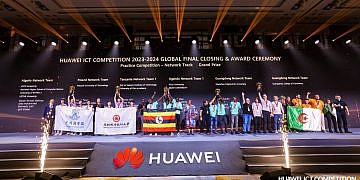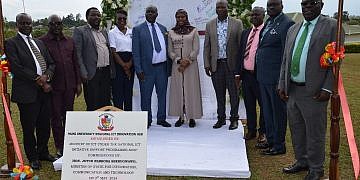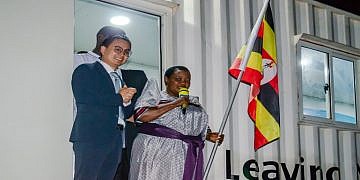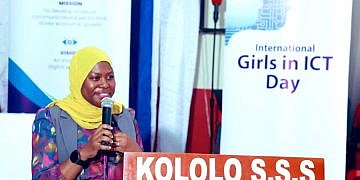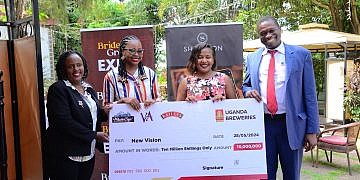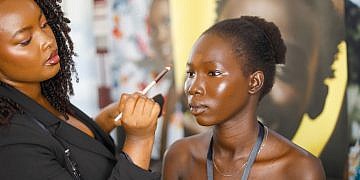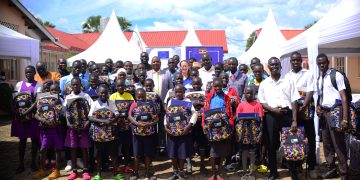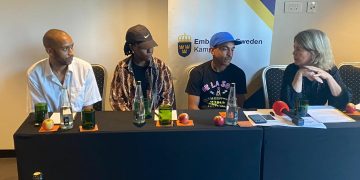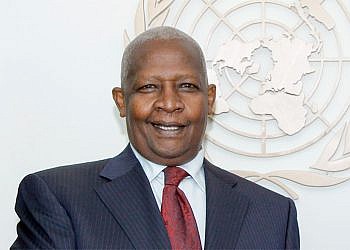President Museveni has described the late for Chief of Defence Forces, Gen Aronda Nyakairima as a rare treasure who contributed immensely to the UPDF and country at large.
“When Gen. Aronda became CDF, he easily contributed to the discipline of the Army, because the Political Commissars were a disciplined group. The Political Commissars also understood the strategic relationship with the people. Most important of all, Gen. Aronda was among those that understood very well our four ideological principles and 3 historical missions. It is those officers that fully understand our involvements in South Sudan, Congo, Somalia, etc,” Museveni said on Tuesday during the first Gen Aronda Nyakairima memorial lecture at Speke Convention Centre in Munyonyo.
Here is President Museveni’s speech in full;
You cannot talk of the Late General Aronda Nyakairima’s role or that of other NRA/UPDF personnel, without understanding the Africa of 1900 at the dawn of colonialism and what happened subsequently. While much of Africa had been ravaged by the slave trade for 400 years, our part of Africa had not been so much affected by the slave trade, although there were some isolated incidents of slave snatching.
The late Aron Muhiinda who, I remember very well died in 1955, when I was in Primary three, had been liberated from slavery at the Coast of Mombasa. He is the grandfather of our Permanent Secretary for Tourism, Silva Katusiime. They were being captured in tribal wars fomented by the bankrupt kings and, then, sold in slavery.
However, the whole of Africa and, indeed, our part of Africa, was still in the pre-capitalist mode of production and society. The societies were feudal or pre-feudal primitive communalism societies.
The production of wealth was organized in emyooga (specialized skills) such as okuhiinga (growing crops), kuriisa (cattle herding and general livestock keeping), okuheesha (black- smithing), okubaija (carpentry), okunogoora (pottery), okukomaga (bark cloth making), Okutanaga (making bows and arrows), okurema (shoe making), okuhara (leather making), okujuba (fishing), okushakyiira (general medical works), okuragura (divination), okugyeenga(surgery), sailing (Abariimbi) etc., etc.
These emyooga, were being done by communities, clans or families on a hereditary basis.
They would, then, okuchurika (barter trade) with the other families to get what they needed but did not make themselves. The long distance trade to the Coast was being done by the Balungaanwa (the Waungwana), mainly the Ba nyamwezi from Tabora in Tanzania. They would bring textiles (emyenda), glass– beads (enkwaanzi), guns (embuundu), obugaanga (guns-powder), etc. There was some limited use of cowrie shells (ensiimbi) as money.
That is why one of the words for money is ensiimbi. The other word for money is empiiha (Rupiah).
Museveni attending the defence expo at Commonwealth Resort Munyonyo in Kampala on Tuesday
However, the pre-colonial dominant mode of trade, was by barter trade with, mainly abebuunzi (the itinerant, hawking traders). Okubuunzya, is to hawk. The luganda word for hawkers is abatembeyi.
When the colonialists, following the imperialists Berlin Conference, divided up Africa as a cake in 1884-85, Uganda was allocated to the British who, in 1903, introduced cotton as a cash-crop. They also introduced the shilling as a currency for their East African Empire, issued by the East African Currency Board, based in Aden I think.
The colonial invasion, destroyed many of the emyooga, especially, the handcrafts – pangas, hoes, plates, spoons, pots, shoes, bark cloth, chairs, etc., were now replaced by imported items by the imperialists. Hence, the surviving emyooga people retreated into making merely ornamental items like drums, emirebe (cow-bells), etc.
Enclave
By 1962 when the British were forced to retreat, they had created a small enclave (island) of money economy characterized as the economy of the 3Cs and 3Ts. The 3Cs, were: cotton, coffee and copper; and the 3Ts were: Tobacco, Tourism and Tea.
According to the census of 1969, these absorbed a percentage of the home steads . Otherwise, the rest of the economy was a non-money economy comprised of okukolera ekidda kyonkya (working only for the stomach – subsistence economy).
This meant mass poverty in the midst of plentiful natural resources – land, water, livestock, forests minerals, etc. Resources rich but undeveloped, with a poor population all over the country – poor housing, poor health, dirty water, no education, poor hygiene, poor nutrition, only manual labour (obubweijana), no transport, etc.
Even by 2013, a whole 68% of the homesteads, of Uganda, were still in the non-money economy (abakolera ekidda kyoonka). That is why I had to involve the UPDF in the form of OWC.
By 2021, the figures were showing that that figure had shrank to 39%. What is it now? The new census, will tell us.
In the meantime, in 1971, Idi Amin came on the scene – totally oblivious to the ideas of the modern economy.
By 1986, when the NRM came into power, the small enclave economy had almost disappeared. Of the 3Cs, only coffee was still limping on. The other two – cotton and copper- had disappeared. Of the 3Ts, only tobacco was still limping on. Tourism and tea had disappeared.
Ever since 1900, when the whole of the African continent except for Ethiopia had capitulated to imperialism, the African peoples, led by new forces, had launched a massive anti-colonial struggle, led by the ANC of South African in 1912 but also with some participation by some Pan-Africanist African-Americans such as Du bois, Padamore, Marcus Garvey, etc.
By the time we came on the scene as a student movement but also as youth members of the neo- colonial political parties of Uganda at that time, we had to distil accurate political ideas from the confusion that characterizes many struggles.
In particular, we had to reject the politics of identity of tribes and religion that the opportunists were pushing, that time and eversince. After a decade of analysis, by the time we metamorphosed into a liberation movement with the launch of the anti- Amin struggle, we had arrived at a diagnosis of what we thought was the problem of Uganda and, maybe, Africa.
We identified three problems: Lack of prosperity; lack of strategic security; and the failure to use the clear brotherhood of the African Peoples.
Then, the next question was: “Who will buy in big quantities and sustainably what you produce – the goods or services? It is the answer to this question, that helped us to debunk the Psendo politics of identity.
We found that many Banyankore did not buy the milk, the beef or the bananas, which are the products of theirs. Why? It was because many of them have similar products.
A does not buy from B and vice-versa. Who, then, are the buyers that, mainly, buy what the Banyankole produce? It is, mainly, the non-Banyankole or the Banyankole living in towns that buy the milk, the beef and the bananas of the Banyankore.
Therefore, the prosperity of the Banyankore is more dependent on Uganda, rather than on the Banyankore rural areas, beyond the production of the goods and services. This is how we identified the first ideological principle of the NRM as Patriotism. Love Uganda. Why? It is because you need it, for your prosperity. We soon found out that the internal market of Uganda, was not enough.
Hence, the need for the regional and continental markets of Africa. We had, therefore, to love Africa. Why? It is because we need it for our prosperity. Hence, the second principle of the NRM – Pan- Africanism.
The third principle is social-economic transformation so as to be able to produce the goods and services that are needed in the Ugandan market and the African market.
Democracy is our principle number four.
These four address the historical mission of creating prosperity for our people.
The next historical mission is to create strategic security for Africa against all threats. You have heard of some actors in the World working for achieving four dimensional superiority: superiority in the land forces; superiority in air forces; superiority at sea; and superiority in space.
Where does that leave Africa?
Uganda, relying on the four ideological principles, will become a first World Country. We have already achieved the low middle income status with the GDP per capita of USD1,146.
However, the question is: Can Uganda afford an Ocean going navy or a deterrent space capacity even when it becomes a first World Country?
USA, Russia, China and India, have been to the moon. UK, Germany, France, Japan, etc., have not been to the moon. UK, Germany, France, Japan, etc., have not been to the moon, their being first World Countries notwithstanding. What does this mean? It means that there is meaning to size.
Small is small, whether developed or not. During the 2nd World War, the first victims of German aggression were the highly developed Countries of France, Belgium, Holland, Denmark, Norway, etc. Therefore size matters.
That is why the NRM stood with Mwalimu Nyerere on the issue of the East African Federation.
We need the East African Federation for our strategic security. We need a powerful Defence Force with the ability to defend us in the four spheres: land, air, sea and in space.
Hence, the two elements Pan-Africanism: common market to deal with our prosperity and political Federation to deal with our strategic security- the ability to defend us against all and sundry.
That leads us to our third historical mission- the brotherhood of the African peoples.
You have heard it broadcast repeatedly by the reactionaries and traitors, that Africa is populated by very many tribes, etc.,etc.
In fact, the 1.5 billion people, who will be 2.5 billion in the next 26 years, are only divided in 4 linguistic groups: the Niger-Congo (the Bantus and the Kwa); the Nilo-Saharan (Nilotic, Cushitic, Nilo-Hamitic, etc.); the Afro-Asiatic (Arabic, Tigrinya, Amhara, etc.); and the Khoisan of Southern African (the bushmen). Moreover, we have Swahili which is a non-tribal language that has distilled a new language from the Bantu dialects, Arabic, Portuguese etc.
It is, therefore, possible to unite these African peoples for the sake of their prosperity and strategic security, but also enhance cohesion.
With those principles and the historical missions, the student movement was able to challenge the bankrupt ideology of the politics of identity (tribes and religion and gender–chauvinism).
Peasants
It is this ideological menu, that we were serving our trainees in the Fronasa camps in the 1970s. At that time, our recruits were mainly peasants or Secondary School Leavers. These are the people we trained at Montepuez in 1976-1978. However, following our crossing the Kagyera River along with the Tanzanian Army on the 11th of February, 1979, we started recruiting University graduates, such as Eli Tumwiine, in addition to the school leavers. In the 2nd half of 1981, the NRA had a fresh intake of new University graduates – Aronda, Tumukunde, Kasula, Sande Mukulu, Bariyo Barigye, Ndibarema, etc.
On account of education and ability to write and read, they helped us to man the intelligence departments and being Political Commissars.
The Combat Commanders were, mainly, the Secondary School Leavers and peasants: Pecos Kutesa, Fred Mugyisha, Patrick Lumumba, Steven Kashaka, Kyaligonza, Julius Kyihaanda, Chefe Ali, Ivan Koreta, Samson Mande, Adam Wasswa, Peter Kerim, Benon Tumukunde, etc.
These were the commanders of the Brigades that assaulted Kampala, starting on the 17th of January.
The only University graduate in command that time was Tunyefuuza on the Western axis commanding forces that included the 19th BN (bde) of Peter Kerim at Biiso.
The graduates were jokingly called intellectuals. Those intellectuals, on account of better discipline, came to save the Army, when many of the combat commanders died from natural causes.
Given the training we had given them under OBC, in Russia, in the USA, etc., they filled the gaps left by the deceased combat commanders and gave us time for the maturing of the younger officers we deliberately recruited in the 1990s to rebuild the officer – Corp of the Defence Forces.
The new officers had better opportunities to develop organically – level by level – because of the facilities in the country and also abroad.
The officer could advance level by level: Officer Cadet, Platoon Commanders’ course, Staff College, NDC, professional courses, etc.
In the recruitments we carried out when already in Government, we got a lot of A–level school leavers and graduates who learn quickly. When the French trainers came to help us build our mountain Division, I remember them remarking to me about how our officers were learning quickly.
When Gen. Aronda became CDF, he easily contributed to the discipline of the Army, because the Political Commissars were a disciplined group. The PCs also understood the strategic relationship with the people. Most important of all, Gen. Aronda was among those that understood very well our four ideological principles and 3 historical missions. It is those officers that fully understand our involvements in South Sudan, Congo, Somalia, etc.
Therefore, Gen. Aronda was outstanding on ideology, discipline but also management skills. He took the lead in starting the Wazalendo Sacco.
We had talked about this but it had not been implemented.
In conclusion, three points. All Armies in history have and had historical missions. The head of the British Army in the Second World War, if my memory still serves me well, was a Field Marshal going by the title of the Chief of the Imperial General Staff (CIGS). His names were Allan Brooke.
What was the mission of that Army? To colonize, subjugate and exploit the backward peoples of the World that were led by stupid, narrow-minded and selfish kings like ours here in Uganda.
Field Marshal Zhukou headed the Red Army in the 2nd World War. What was its historical mission? To liberate the peasants and the workers of Russia from feudalism and defend Russia against the imperialists that wanted to subjugate their country.
What was the historical mission of the continental Army of Washington? To get rid of the British king that was taxing the white settlers (mainly British) without allowing them to elect their representatives (the Boston Tea Party). What was the historical mission of the King of the Riffle (KAR), that was baptized as UR at Independence and quickly renamed UA? To be agents of foreign interest.
In Tanzania, Mwalimu Nyerere managed to re- organise the colonial Tanganyika Rifles into TPDF after their mutiny of 1964. In Uganda, that was never done.
Hence, all the problems we had with that small Army of 8000 by 1971 and 20,000 by 1979. It was, therefore, imperative that we build an Army of a new type – Patriotic, Pan-Africanist, working for the social-economic transformation of our society and for people’s power through democracy.
Therefore, the second point is that people like Gen. Aronda, educated and from the oppressed masses, came forward to join the Resistance we had initiated right from the student days. Their education and ability to write and read documents in English, quickly qualified them to work in the intelligence and political sections of the Army.
Some like Tinyefuuza, Magara, Tumwine, Tumukunde Henry, Sande Mukulu, etc., also took on combat roles early in fighting. As already pointed out above, even the PCs, having undertaken command courses after the NRM came to power, were able to feel the gaps created by the massive deaths caused by natural causes among the historical Combat Commanders.
The UPDF/NRA/Fronasa was able to, broadly speaking, maintain its trajectory of launching Uganda on the path of liberation.
Three and, finally, inspite of the achievements scored, I have noticed some weaknesses, especially corruption and inadequate training.
Corruption
There have been cases of stealing Army fuel, Army rations, Pension money, allowances and salaries and corruption in the selection of personnel to go for external missions, such as Somalia.
The disaster we had sometime ago in one of the Defended positions where we lost 57 soldiers, was apparently, caused by this type corruption.
Of course, the majority of the Army are clean. That is how we end up getting this information. There is also the misuse of Army resources. The present CDF started fighting that some time ago when he took over the command of SFC and the Land forces.
He was able to use the money that was being misused, to build barracks for soldiers. As we remember the patriotic Commanders such as the Late General Aronda Nyakairima, you need to torch among yourselves and find out these elements that cause this pollution.
The failure by some commanders to implement the NRA collective welfare, formulae is also a mistake.
The late Gen Aronda implemented the formula of Wazalendo. Has it not helped the soldiers? Why, then, not all the others – barracks so that soldiers do not have to stay in mizigo in Trading Centres,Army schools for soldiers’ children, health units for soldiers and their families, salary loans for soldiers’ children in Universities, etc? Feel the gaps and UPDF will be formidable.
Long live the memory of our fighters like Gen. Aronda, may the Almighty God bless their descendants as a reward for their Patriotic service.
Yoweri K. Museveni
PRESIDENT


